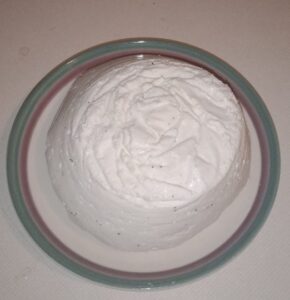
rediscovered a gallon of milk lurking at the back of my fridge, perilously close to its expiration date. Rather than let it go to waste, I decided to whip up some farmer’s cheese. It’s a simple and economical process.
Ingredients:
- 1 gallon of whole milk (I used Walmart brand)
- 1/2 cup of distilled white vinegar (also Walmart brand)
Instructions:
- Heat the gallon of milk over medium-low heat until you start seeing numerous tiny bubbles forming, but avoid bringing it to a boil. (If using a nonstick pot, adjust the heat slightly higher, but stir more frequently to prevent scorching).
- Once you notice the bubbles, gradually add the 1/2 cup of distilled white vinegar, stirring gently. Allow it to sit for 30-60 seconds, then stir again. You’ll see the milk curdle, forming crumbles, and the liquid turning a lime/yellow-ish color. Remove from heat and let it cool to room temperature.
- Line a sieve or colander with a flour sack towel or tea towel. Slowly pour the curdled milk into the cloth to strain out the whey. Gather the cloth around the cheese and squeeze out as much liquid as possible. Stop when the liquid runs clear.
- If you wish to save the whey, drain it into a separate bowl. Whey can be used in bread-making, cooking, or gardening.
- The resulting cheese is mild in taste, similar to ricotta, and has a texture that can range from crumbly to soft, depending on how much whey you remove. It can be stored in the fridge for 7-10 days, and if using it in desserts or bread recipes, it can also be frozen. Simply wrap tightly in plastic wrap and place in a freezer bag.
This versatile cheese can be used in various dishes, such as pancakes, sweet bread, rolls, crepes, and blintzes. You can also create a flavorful appetizer spread by adding salt, pepper, and spices to the cheese before shaping it into a ball, wrapping it in plastic wrap, and chilling. It’s perfect for spreading on crackers, incorporating into Italian recipes (it melts beautifully), or crumbling over a salad




















